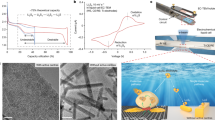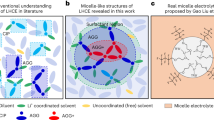Abstract
The solid–electrolyte interphase (SEI) dictates the performance of most batteries, but the understanding of its chemistry and structure is limited by the lack of in situ experimental tools. In this work, we present a dynamic picture of the SEI formation in lithium-ion batteries using in operando liquid secondary ion mass spectrometry in combination with molecular dynamics simulations. We find that before any interphasial chemistry occurs (during the initial charging), an electric double layer forms at the electrode/electrolyte interface due to the self-assembly of solvent molecules. The formation of the double layer is directed by Li+ and the electrode surface potential. The structure of this double layer predicts the eventual interphasial chemistry; in particular, the negatively charged electrode surface repels salt anions from the inner layer and results in an inner SEI that is thin, dense and inorganic in nature. It is this dense layer that is responsible for conducting Li+ and insulating electrons, the main functions of the SEI. An electrolyte-permeable and organic-rich outer layer appears after the formation of the inner layer. In the presence of a highly concentrated, fluoride-rich electrolyte, the inner SEI layer has an elevated concentration of LiF due to the presence of anions in the double layer. These real-time nanoscale observations will be helpful in engineering better interphases for future batteries.
This is a preview of subscription content, access via your institution
Access options
Access Nature and 54 other Nature Portfolio journals
Get Nature+, our best-value online-access subscription
$29.99 / 30 days
cancel any time
Subscribe to this journal
Receive 12 print issues and online access
$259.00 per year
only $21.58 per issue
Buy this article
- Purchase on Springer Link
- Instant access to full article PDF
Prices may be subject to local taxes which are calculated during checkout





Similar content being viewed by others
Data availability
All data that support the findings of this study have been included in the main text and Supplementary Information. The original data are archived at the Environmental Molecular Sciences Laboratory at Pacific Northwest National Laboratory and are available from the corresponding authors upon reasonable request.
Code availability
The original code for MD simulation is kept at the Environmental Molecular Sciences Laboratory at Pacific Northwest National Laboratory and is available from the corresponding authors upon reasonable request.
References
Xu, K. Nonaqueous liquid electrolytes for lithium-based rechargeable batteries. Chem. Rev. 104, 4303–4418 (2004).
Gauthier, M. et al. Electrode–electrolyte interface in Li-ion batteries: current understanding and new insights. J. Phys. Chem. Lett. 6, 4653–4672 (2015).
Xu, K. Electrolytes and interphases in Li-ion batteries and beyond. Chem. Rev. 114, 11503–11618 (2014).
Smith, A. J., Burns, J. C., Trussler, S. & Dahn, J. R. Precision measurements of the Coulombic efficiency of lithium-ion batteries and of electrode materials for lithium-ion batteries. J. Electrochem. Soc. 157, A196–A202 (2010).
Shim, J., Kostecki, R., Richardson, T., Song, X. & Striebel, K. A. Electrochemical analysis for cycle performance and capacity fading of a lithium-ion battery cycled at elevated temperature. J. Power Sources 112, 222–230 (2002).
Menkin, S., Golodnitsky, D. & Peled, E. Artificial solid-electrolyte interphase (SEI) for improved cycleability and safety of lithium-ion cells for EV applications. Electrochem. Commun. 11, 1789–1791 (2009).
Winter, M. The solid electrolyte interphase—the most important and the least understood solid electrolyte in rechargeable Li batteries. Z. Phys. Chem. 223, 1395–1406 (2009).
Wang, X. F. et al. New insights on the structure of electrochemically deposited lithium metal and its solid electrolyte interphases via cryogenic TEM. Nano Lett. 17, 7606–7612 (2017).
Zachman, M. J., Tu, Z. Y., Choudhury, S., Archer, L. A. & Kourkoutis, L. F. Cryo-stem mapping of solid–liquid interfaces and dendrites in lithium-metal batteries. Nature 560, 345–349 (2018).
Zhu, Z. et al. In situ mass spectrometric determination of molecular structural evolution at the solid electrolyte interphase in lithium-ion batteries. Nano Lett. 15, 6170–6176 (2015).
Frackowiak, E. & Béguin, F. Carbon materials for the electrochemical storage of energy in capacitors. Carbon 39, 937–950 (2001).
Yang, C. et al. 4.0 V aqueous Li-ion batteries. Joule 1, 122–132 (2017).
Gourdin, G., Zheng, D., Smith, P. H. & Qu, D. In situ electrochemical–mass spectroscopic investigation of solid electrolyte interphase formation on the surface of a carbon electrode. Electrochim. Acta 112, 735–746 (2013).
Wang, F. et al. Hybrid aqueous/non-aqueous electrolyte for safe and high-energy Li-ion batteries. Joule 2, 927–937 (2018).
Sacci, R. L. et al. Nanoscale imaging of fundamental Li battery chemistry: solid–electrolyte interphase formation and preferential growth of lithium metal nanoclusters. Nano Lett. 15, 2011–2018 (2015).
Leenheer, A. J., Jungjohann, K. L., Zavadil, K. R., Sullivan, J. P. & Harris, C. T. Lithium electrodeposition dynamics in aprotic electrolyte observed in situ via transmission electron microscopy. ACS Nano 9, 4379–4389 (2015).
Mehdi, B. L. et al. Observation and quantification of nanoscale processes in lithium batteries by operando electrochemical (S)TEM. Nano Lett. 15, 2168–2173 (2015).
Cresce, Av, Russell, S. M., Baker, D. R., Gaskell, K. J. & Xu, K. In situ and quantitative characterization of solid electrolyte interphases. Nano Lett. 14, 1405–1412 (2014).
Liu, T. C. et al. In situ quantification of interphasial chemistry in Li-ion battery. Nat. Nanotechnol. 14, 50–56 (2019).
Oswald, S., Nikolowski, K. & Ehrenberg, H. Quasi in situ XPS investigations on intercalation mechanisms in li-ion battery materials. Anal. Bioanal. Chem. 393, 1871–1877 (2009).
Nazri, G. & Muller, R. H. In situ X‐ray diffraction of surface layers on lithium in nonaqueous electrolyte. J. Electrochem. Soc. 132, 1385–1387 (1985).
Wagner, M. R., Albering, J. H., Moeller, K. C., Besenhard, J. O. & Winter, M. XRD evidence for the electrochemical formation of in PC-based electrolytes. Electrochem. Commun. 7, 947–952 (2005).
Bhattacharyya, R. et al. In situ NMR observation of the formation of metallic lithium microstructures in lithium batteries. Nat. Mater. 9, 504–510 (2010).
Zhang, Y. Y. et al. Potential-dynamic surface chemistry controls the electrocatalytic processes of ethanol oxidation on gold surfaces. ACS Energy Lett. 4, 215–221 (2019).
Wang, J. G. et al. Direct molecular evidence of proton transfer and mass dynamics at the electrode–electrolyte interface. J. Phys. Chem. Lett. 10, 251–258 (2019).
Qian, J. F. et al. High rate and stable cycling of lithium metal anode. Nat. Commun. 6, 6362 (2015).
Edström, K., Herstedt, M. & Abraham, D. P. A new look at the solid electrolyte interphase on graphite anodes in Li-ion batteries. J. Power Sources 153, 380–384 (2006).
Wang, C., Meng, Y. S. & Xu, K. Perspective—fluorinating interphases. J. Electrochem. Soc. 166, A5184–A5186 (2019).
Suo, L. M. et al. ‘Water-in-salt’ electrolyte enables high-voltage aqueous lithium-ion chemistries. Science 350, 938–943 (2015).
Fan, X. L. et al. Non-flammable electrolyte enables Li-metal batteries with aggressive cathode chemistries. Nat. Nanotechnol. 13, 715–722 (2018); erratum 13, 1191 (2018).
Lu, P. & Harris, S. J. Lithium transport within the solid electrolyte interphase. Electrochem. Commun. 13, 1035–1037 (2011).
Hayamizu, K., Aihara, Y., Arai, S. & Martinez, C. G. Pulse-gradient spin-echo 1H, 7Li, and 19F NMR diffusion and ionic conductivity measurements of 14 organic electrolytes containing LiN(SO2CF3)2. J. Phys. Chem. B 103, 519–524 (1999).
Cresce, A. V. et al. Anion solvation in carbonate-based electrolytes. J. Phys. Chem. C 119, 27255–27264 (2015).
Nie, M. & Lucht, B. L. Role of lithium salt on solid electrolyte interface (SEI) formation and structure in lithium ion batteries. J. Electrochem. Soc. 161, A1001–A1006 (2014).
Ding, Y. Z. et al. In situ molecular imaging of the biofilm and its matrix. Anal. Chem. 88, 11244–11252 (2016).
Wang, J. et al. Superconcentrated electrolytes for a high-voltage lithium-ion battery. Nat. Commun. 7, 12032 (2016).
Wan, C. et al. Multinuclear NMR study of the solid electrolyte interface formed in lithium metal batteries. ACS Appl. Mater. Interface 9, 14741–14748 (2017).
Nie, M. et al. Role of solution structure in solid electrolyte interphase formation on graphite with LiPF6 in propylene carbonate. J. Phys. Chem. C 117, 25381–25389 (2013).
von Cresce, A. & Xu, K. Electrolyte additive in support of 5 V Li ion chemistry. J. Electrochem. Soc. 158, A337–A342 (2011).
Zhang, Q. et al. Synergetic effects of inorganic components in solid electrolyte interphase on high cycle efficiency of lithium ion batteries. Nano Lett. 16, 2011–2016 (2016).
Zhou, Y. F. et al. Improving the molecular ion signal intensity for in situ liquid SIMS analysis. J. Am. Soc. Mass Spectrom. 27, 2006–2013 (2016).
Duan, Y. et al. A point-charge force field for molecular mechanics simulations of proteins based on condensed-phase quantum mechanical calculations. J. Comput. Chem. 24, 1999–2012 (2003).
Liu, X. H., Han, Y. N. & Yan, T. Y. Temperature effects on the capacitance of an imidazolium-based ionic liquid on a graphite electrode: a molecular dynamics simulation. ChemPhysChem 15, 2503–2509 (2014).
Borodin, O. Polarizable force field development and molecular dynamics simulations of ionic liquids. J. Phys. Chem. B 113, 11463–11478 (2009).
Hess, B., Kutzner, C., van der Spoel, D. & Lindahl, E. Gromacs 4: algorithms for highly efficient, load-balanced, and scalable molecular simulation. J. Chem. Theory Comput. 4, 435–447 (2008).
Bedrov, D., Borodin, O., Li, Z. & Smith, G. D. Influence of polarization on structural, thermodynamic, and dynamic properties of ionic liquids obtained from molecular dynamics simulations. J. Phys. Chem. B 114, 4984–4997 (2010).
Acknowledgements
This work was supported by Laboratory Directed Research and Development (LDRD) programs (mainly an FY 16 Open Call LDRD and partially Chemical Dynamics Initiative) at Pacific Northwest National Laboratory (PNNL). C.W. thanks the support of the Assistant Secretary for Energy Efficiency and Renewable Energy, Office of Vehicle Technologies of the US Department of Energy under the Advanced Battery Materials Research (BMR) Program and the US–Germany Cooperation on Energy Storage. O.B. and K.X. at ARL were supported as part of the Joint Center for Energy Storage Research, an Energy Innovation Hub funded by the US Department of Energy, Office of Science, Basic Energy Sciences (agreement SN2020957). Battelle operates PNNL for the US Department of Energy (DOE) under Contract DE-AC05- 76RL01830. The research was performed using the Environmental Molecular Sciences Laboratory (EMSL), a national scientific user facility sponsored by the Department of Energy’s Office of Biological and Environmental Research and located at PNNL.
Author information
Authors and Affiliations
Contributions
Z.Z., C.W. and K.X. conceived the project. Y.Zhou prepared the battery cells. Y.Zhou and X.Y. conducted the in situ liquid-SIMS characterizations. Y.Zhou, Y.Zhang and J.W. organized the SIMS data and drew relevant figures. M.S. and Z.X. performed the MD simulations. Z.Z. and Y.Zhou drafted the manuscript with help from C.W. and K.X.. X.R., R.C. and W.X. provided the relevant chemicals. W.X., D.R.B., Y.D., O.B., Y.W. and X.-L.W. contributed to the discussion and revision of the manuscript.
Corresponding authors
Ethics declarations
Competing interests
A US patent (10,505,234 B2) was granted to Battelle Memorial Institute for the protection of the innovation of the liquid battery cell used in this work.
Additional information
Peer review information Nature Nanotechnology thanks Bing Joe Hwang and the other, anonymous, reviewer(s) for their contribution to the peer review of this work.
Publisher’s note Springer Nature remains neutral with regard to jurisdictional claims in published maps and institutional affiliations.
Supplementary information
Supplementary Information
Supplementary discussion, Figs. 1–8 and refs. 1–9.
Rights and permissions
About this article
Cite this article
Zhou, Y., Su, M., Yu, X. et al. Real-time mass spectrometric characterization of the solid–electrolyte interphase of a lithium-ion battery. Nat. Nanotechnol. 15, 224–230 (2020). https://doi.org/10.1038/s41565-019-0618-4
Received:
Accepted:
Published:
Issue Date:
DOI: https://doi.org/10.1038/s41565-019-0618-4
This article is cited by
-
Transition metals for stabilizing lithium metal anode: advances and perspectives
Tungsten (2024)
-
Tracking lithiation with transmission electron microscopy
Science China Chemistry (2024)
-
Imaging solid–electrolyte interphase dynamics using operando reflection interference microscopy
Nature Nanotechnology (2023)
-
Critical role of hydrogen for superconductivity in nickelates
Nature (2023)
-
Near ambient N2 fixation on solid electrodes versus enzymes and homogeneous catalysts
Nature Reviews Chemistry (2023)



